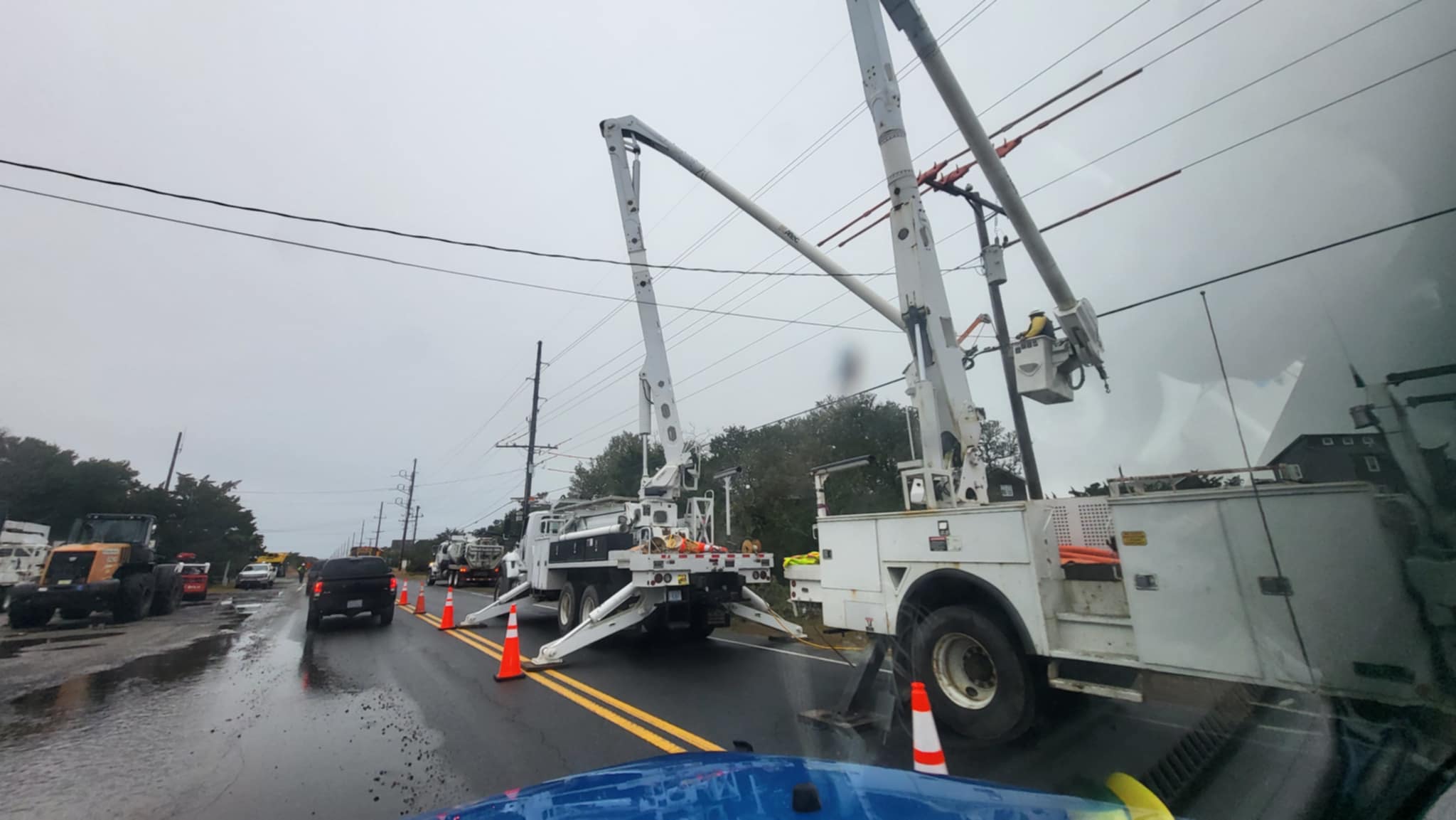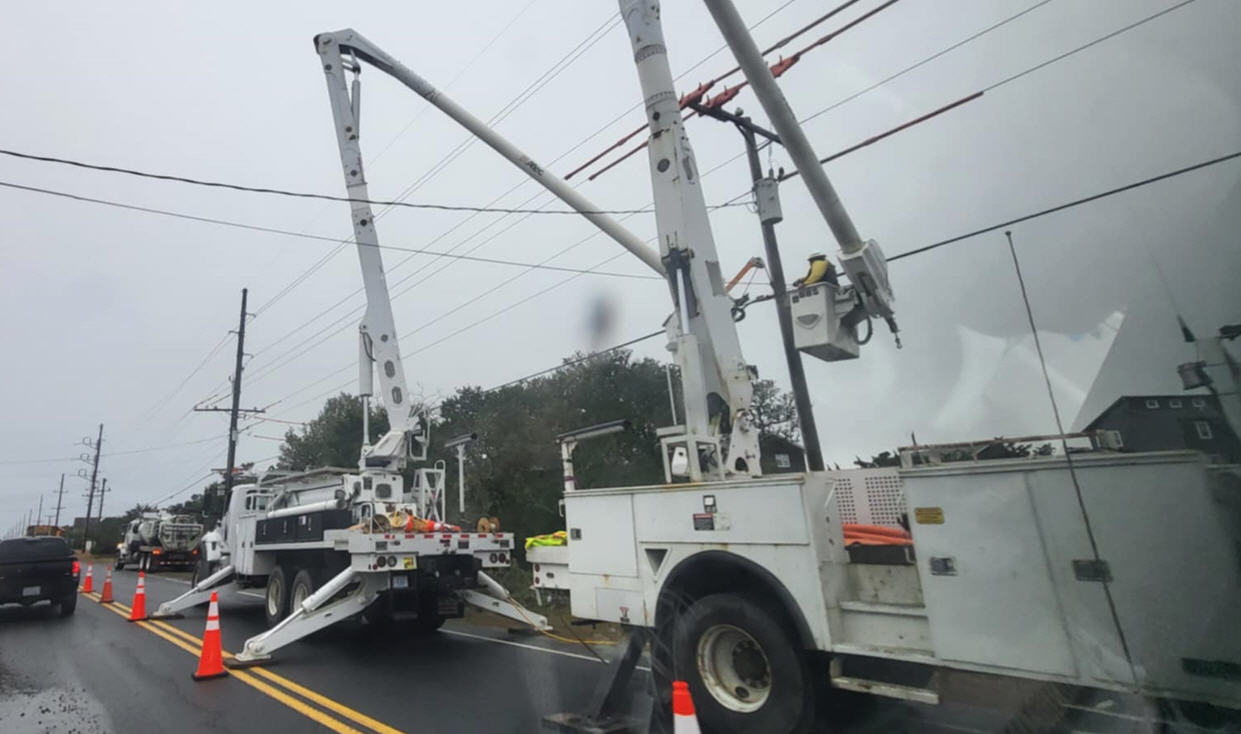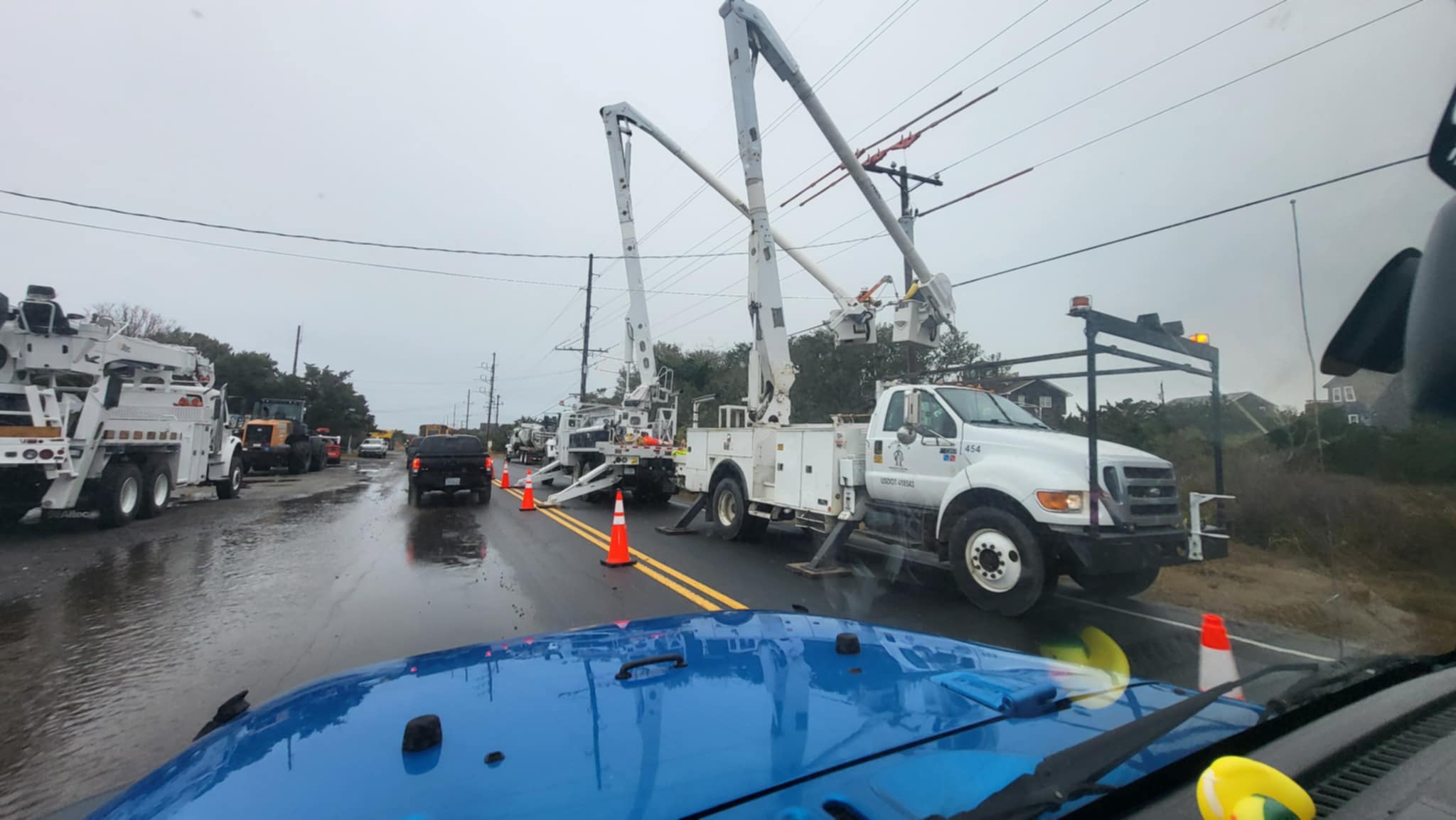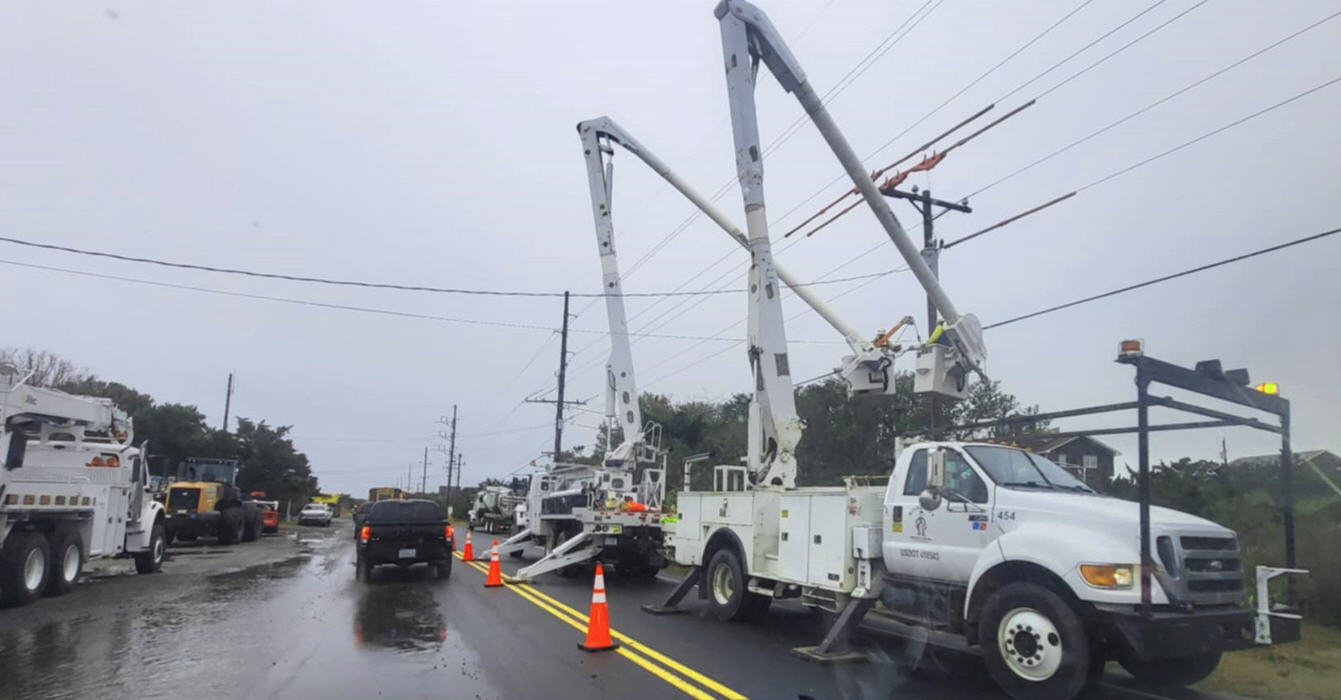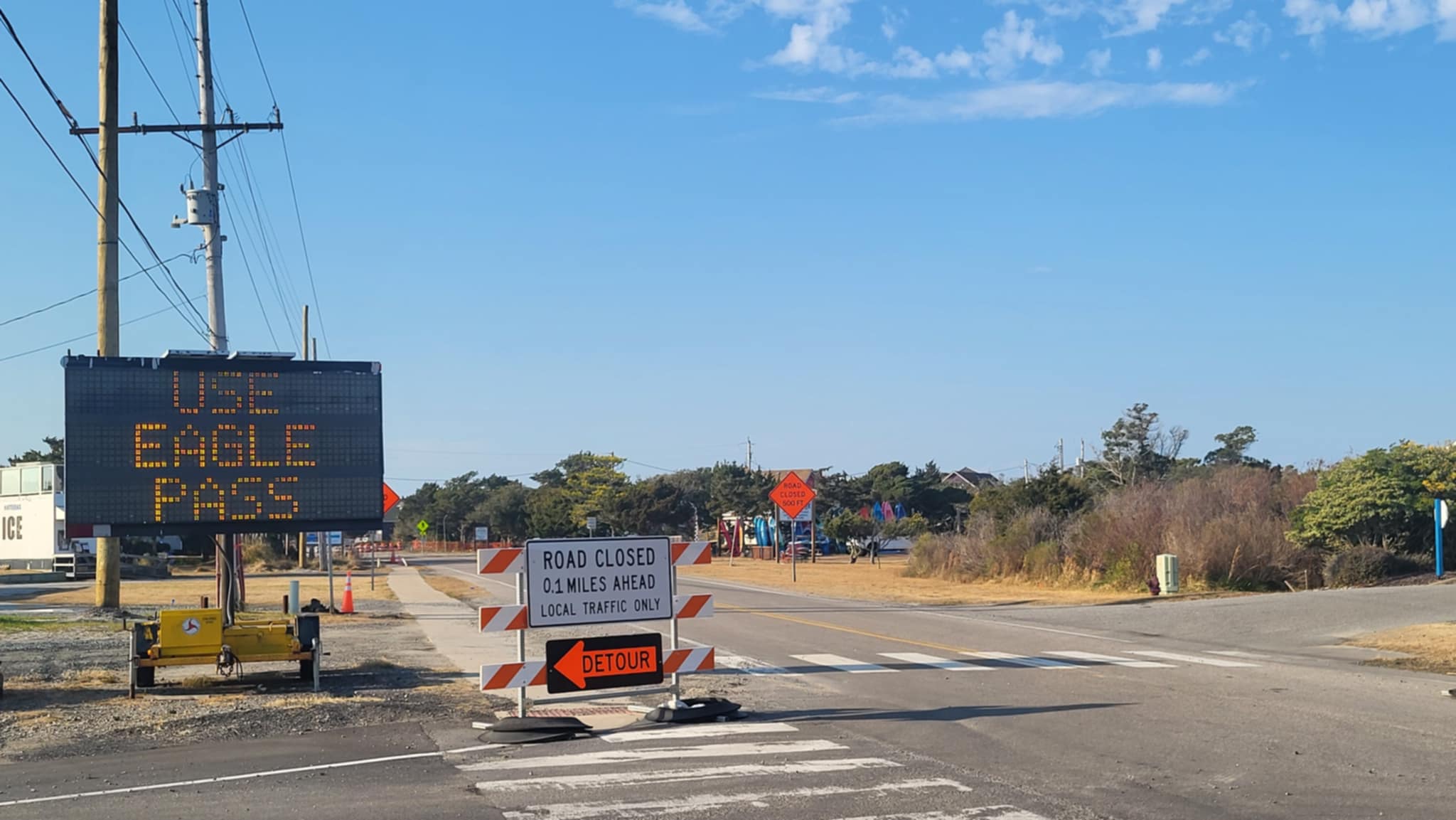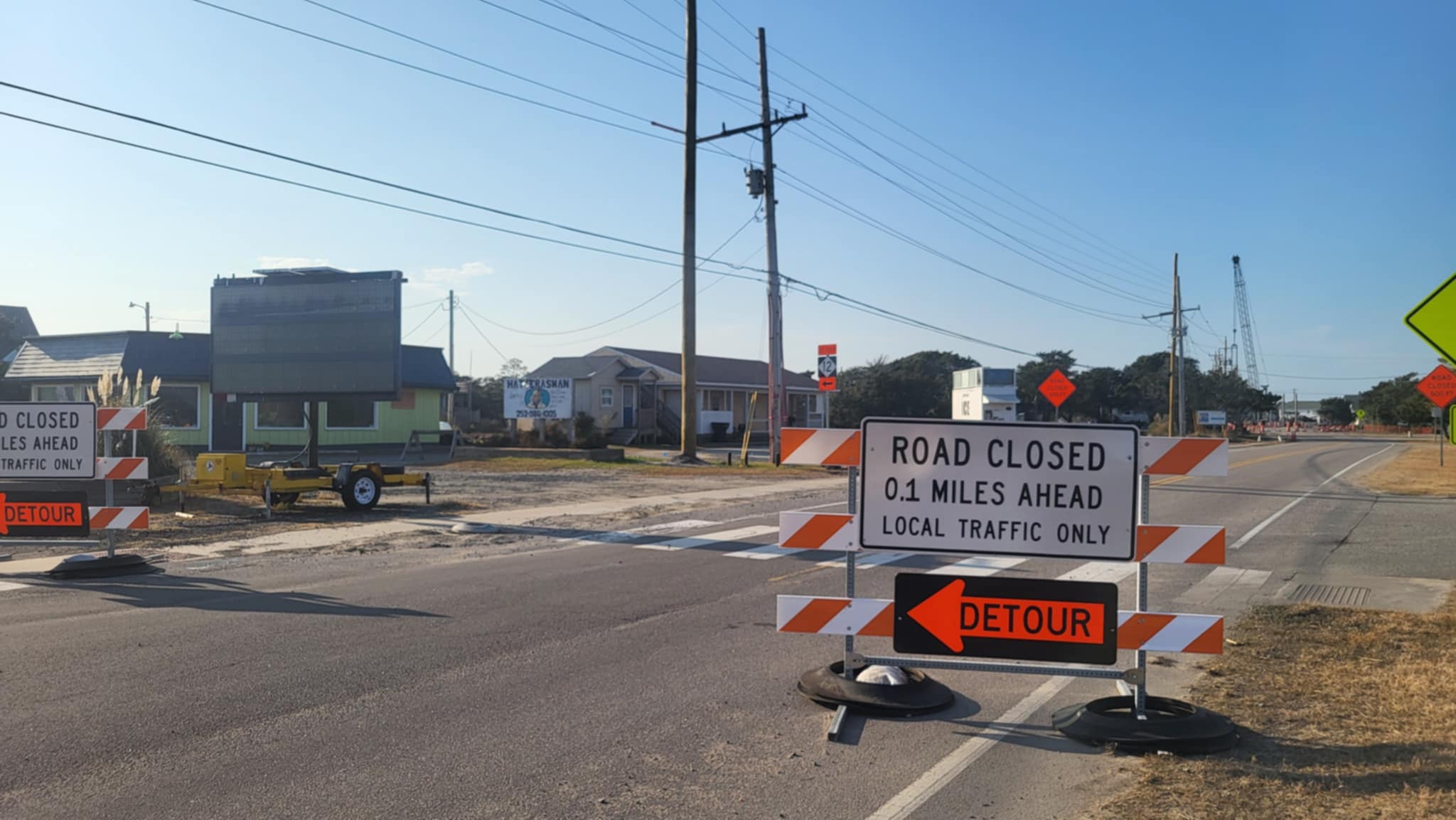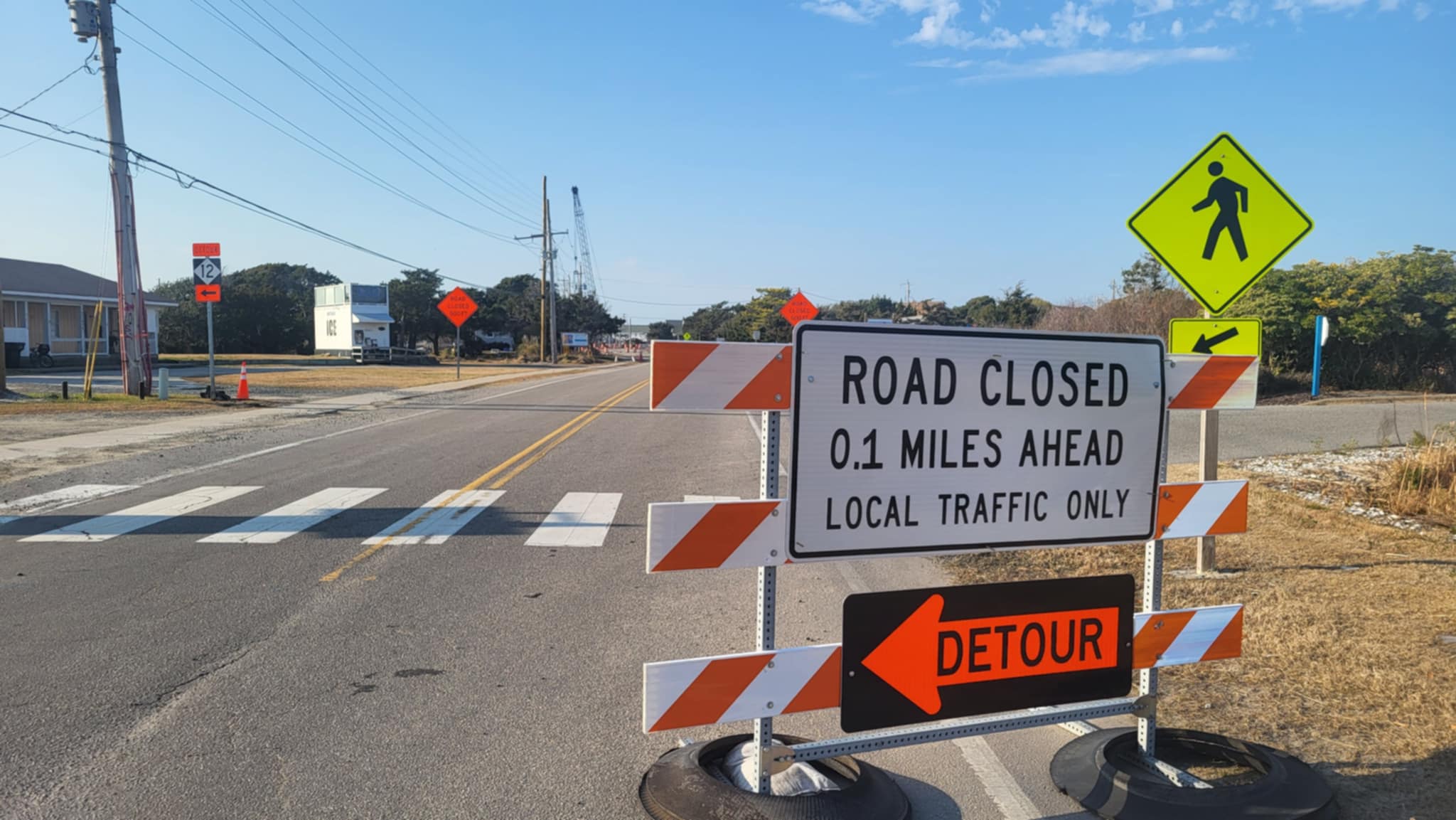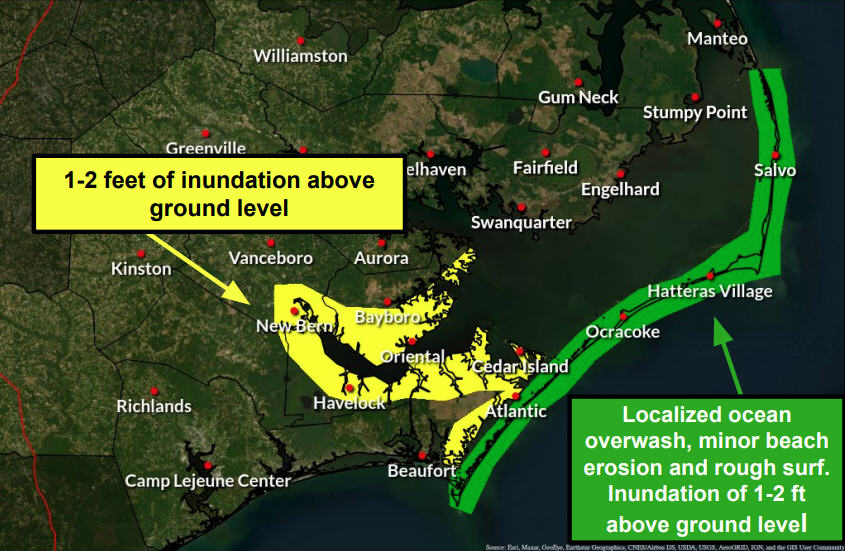The battles for Forts Clark and Hatteras gave the Union its first Civil War victory
The battles for Forts Clark and Hatteras gave the Union its first Civil War victory
By DREW PULLEN
By DREW PULLEN
By DREW PULLEN
On Aug. 28, 1861, the residents of Hatteras Village awakened to the sight of a large Federal fleet anchored off their coast. At about 10 a.m. the peaceful and tranquil life of Hatteras Village was shattered by the sound of the large naval guns of a Union fleet firing on two Confederate forts which were under construction at Hatteras Inlet.
On Aug. 28, 1861, the residents of Hatteras Village awakened to the sight of a large Federal fleet anchored off their coast. At about 10 a.m. the peaceful and tranquil life of Hatteras Village was shattered by the sound of the large naval guns of a Union fleet firing on two Confederate forts which were under construction at Hatteras Inlet.
On Aug. 28, 1861, the residents of Hatteras Village awakened to the sight of a large Federal fleet anchored off their coast. At about 10 a.m. the peaceful and tranquil life of Hatteras Village was shattered by the sound of the large naval guns of a Union fleet firing on two Confederate forts which were under construction at Hatteras Inlet.
On Aug. 28, 1861, the residents of Hatteras Village awakened to the sight of a large Federal fleet anchored off their coast. At about 10 a.m. the peaceful and tranquil life of Hatteras Village was shattered by the sound of the large naval guns of a Union fleet firing on two Confederate forts which were under construction at Hatteras Inlet.
John Rollinson, a local resident of Hatteras Island at the time, wrote in his journal that the Confederate soldiers first arrived at Hatteras on May 9, 1861, one month after the Civil War began. Six Confederate regiments were assigned the responsibility of protecting and guarding over 400 miles of North Carolina Coast. It was 700 men of the 7th North Carolina Troops, under the command of William F. Martin, who were given the responsibility of defending and protecting the forts at Hatteras Inlet.
John Rollinson, a local resident of Hatteras Island at the time, wrote in his journal that the Confederate soldiers first arrived at Hatteras on May 9, 1861, one month after the Civil War began. Six Confederate regiments were assigned the responsibility of protecting and guarding over 400 miles of North Carolina Coast. It was 700 men of the 7th North Carolina Troops, under the command of William F. Martin, who were given the responsibility of defending and protecting the forts at Hatteras Inlet.
John Rollinson, a local resident of Hatteras Island at the time, wrote in his journal that the Confederate soldiers first arrived at Hatteras on May 9, 1861, one month after the Civil War began. Six Confederate regiments were assigned the responsibility of protecting and guarding over 400 miles of North Carolina Coast. It was 700 men of the 7th North Carolina Troops, under the command of William F. Martin, who were given the responsibility of defending and protecting the forts at Hatteras Inlet.
John Rollinson, a local resident of Hatteras Island at the time, wrote in his journal that the Confederate soldiers first arrived at Hatteras on May 9, 1861, one month after the Civil War began. Six Confederate regiments were assigned the responsibility of protecting and guarding over 400 miles of North Carolina Coast. It was 700 men of the 7th North Carolina Troops, under the command of William F. Martin, who were given the responsibility of defending and protecting the forts at Hatteras Inlet.
Forts Hatteras and Clark were reportedly constructed by slave labor. The walls, or parapets, of the forts were built of brush, sand and sod. Orders issued from a Major Thompson, C.S. Army Chief Engineer of the Department of Coast Defense, dated July 26, 1861, say:
Forts Hatteras and Clark were reportedly constructed by slave labor. The walls, or parapets, of the forts were built of brush, sand and sod. Orders issued from a Major Thompson, C.S. Army Chief Engineer of the Department of Coast Defense, dated July 26, 1861, say:
Forts Hatteras and Clark were reportedly constructed by slave labor. The walls, or parapets, of the forts were built of brush, sand and sod. Orders issued from a Major Thompson, C.S. Army Chief Engineer of the Department of Coast Defense, dated July 26, 1861, say:
Forts Hatteras and Clark were reportedly constructed by slave labor. The walls, or parapets, of the forts were built of brush, sand and sod. Orders issued from a Major Thompson, C.S. Army Chief Engineer of the Department of Coast Defense, dated July 26, 1861, say:
“First, erect the magazine and bombproof, and then the traverses, as shown upon the drawing, binding the material throughout at every foot of elevation by brush of proper dimensions, in order that they may stand as nearly vertical as possible. These will be 15 feet wide at the bottom and battered so as to have a width at the top pf 7 1/2 to 8 feet, and 7 to 8 feet high, the sod will be secured by stakes…”
“First, erect the magazine and bombproof, and then the traverses, as shown upon the drawing, binding the material throughout at every foot of elevation by brush of proper dimensions, in order that they may stand as nearly vertical as possible. These will be 15 feet wide at the bottom and battered so as to have a width at the top pf 7 1/2 to 8 feet, and 7 to 8 feet high, the sod will be secured by stakes…”
“First, erect the magazine and bombproof, and then the traverses, as shown upon the drawing, binding the material throughout at every foot of elevation by brush of proper dimensions, in order that they may stand as nearly vertical as possible. These will be 15 feet wide at the bottom and battered so as to have a width at the top pf 7 1/2 to 8 feet, and 7 to 8 feet high, the sod will be secured by stakes…”
“First, erect the magazine and bombproof, and then the traverses, as shown upon the drawing, binding the material throughout at every foot of elevation by brush of proper dimensions, in order that they may stand as nearly vertical as possible. These will be 15 feet wide at the bottom and battered so as to have a width at the top pf 7 1/2 to 8 feet, and 7 to 8 feet high, the sod will be secured by stakes…”
Fort Hatteras, the largest of the two forts, was located and constructed to command all the approaches to Hatteras Inlet by land and by sea. This fort was approximately 120 feet wide at its widest point. The other, Fort Clark, was smaller and built to the east, or oceanside of the island, with a view commanding the ocean approach to the inlet about 7/8 of a mile from Fort Hatteras.
Fort Hatteras, the largest of the two forts, was located and constructed to command all the approaches to Hatteras Inlet by land and by sea. This fort was approximately 120 feet wide at its widest point. The other, Fort Clark, was smaller and built to the east, or oceanside of the island, with a view commanding the ocean approach to the inlet about 7/8 of a mile from Fort Hatteras.
Fort Hatteras, the largest of the two forts, was located and constructed to command all the approaches to Hatteras Inlet by land and by sea. This fort was approximately 120 feet wide at its widest point. The other, Fort Clark, was smaller and built to the east, or oceanside of the island, with a view commanding the ocean approach to the inlet about 7/8 of a mile from Fort Hatteras.
Fort Hatteras, the largest of the two forts, was located and constructed to command all the approaches to Hatteras Inlet by land and by sea. This fort was approximately 120 feet wide at its widest point. The other, Fort Clark, was smaller and built to the east, or oceanside of the island, with a view commanding the ocean approach to the inlet about 7/8 of a mile from Fort Hatteras.
The forts were insufficient in size to provide quarters for all of the soldiers. As a result, tents and temporary wooden huts were erected outside the perimeter of the forts. Two additional encampments were set up in Hatteras Village by Union forces after the capture of the forts called Camp Winfield and Camp Wool.
The forts were insufficient in size to provide quarters for all of the soldiers. As a result, tents and temporary wooden huts were erected outside the perimeter of the forts. Two additional encampments were set up in Hatteras Village by Union forces after the capture of the forts called Camp Winfield and Camp Wool.
The forts were insufficient in size to provide quarters for all of the soldiers. As a result, tents and temporary wooden huts were erected outside the perimeter of the forts. Two additional encampments were set up in Hatteras Village by Union forces after the capture of the forts called Camp Winfield and Camp Wool.
The forts were insufficient in size to provide quarters for all of the soldiers. As a result, tents and temporary wooden huts were erected outside the perimeter of the forts. Two additional encampments were set up in Hatteras Village by Union forces after the capture of the forts called Camp Winfield and Camp Wool.
The Confederate government of North Carolina had authorized privateering (using privately owned vessels armed with small cannon) to seize Northern merchant ships off the Carolina coast. In the one and one-half months preceding the capture of the forts, the privateering ships, operating out of Hatteras Inlet, had seized over 15 Northern merchant ships and their cargoes. It was the seizure of Northern merchant ships out of Hatteras Inlet which caused this planned response by the Union navy and army.
The Confederate government of North Carolina had authorized privateering (using privately owned vessels armed with small cannon) to seize Northern merchant ships off the Carolina coast. In the one and one-half months preceding the capture of the forts, the privateering ships, operating out of Hatteras Inlet, had seized over 15 Northern merchant ships and their cargoes. It was the seizure of Northern merchant ships out of Hatteras Inlet which caused this planned response by the Union navy and army.
The Confederate government of North Carolina had authorized privateering (using privately owned vessels armed with small cannon) to seize Northern merchant ships off the Carolina coast. In the one and one-half months preceding the capture of the forts, the privateering ships, operating out of Hatteras Inlet, had seized over 15 Northern merchant ships and their cargoes. It was the seizure of Northern merchant ships out of Hatteras Inlet which caused this planned response by the Union navy and army.
The Confederate government of North Carolina had authorized privateering (using privately owned vessels armed with small cannon) to seize Northern merchant ships off the Carolina coast. In the one and one-half months preceding the capture of the forts, the privateering ships, operating out of Hatteras Inlet, had seized over 15 Northern merchant ships and their cargoes. It was the seizure of Northern merchant ships out of Hatteras Inlet which caused this planned response by the Union navy and army.
The attack against these forts was the first combined military operation of the Civil War.
The attack against these forts was the first combined military operation of the Civil War.
The attack against these forts was the first combined military operation of the Civil War.
The attack against these forts was the first combined military operation of the Civil War.
A black gun crew on board the Union flagship Minnesota fired upon Fort Clark, thus providing the first deployment of black troops to fire on the Confederacy in the Civil War. The Confederate troops inside Forts Hatteras and Clark were completely unprepared for this assault. Construction of the forts was not yet complete and several of the larger 10-inch Columbiad cannon were not in place and operational.
A black gun crew on board the Union flagship Minnesota fired upon Fort Clark, thus providing the first deployment of black troops to fire on the Confederacy in the Civil War. The Confederate troops inside Forts Hatteras and Clark were completely unprepared for this assault. Construction of the forts was not yet complete and several of the larger 10-inch Columbiad cannon were not in place and operational.
A black gun crew on board the Union flagship Minnesota fired upon Fort Clark, thus providing the first deployment of black troops to fire on the Confederacy in the Civil War. The Confederate troops inside Forts Hatteras and Clark were completely unprepared for this assault. Construction of the forts was not yet complete and several of the larger 10-inch Columbiad cannon were not in place and operational.
A black gun crew on board the Union flagship Minnesota fired upon Fort Clark, thus providing the first deployment of black troops to fire on the Confederacy in the Civil War. The Confederate troops inside Forts Hatteras and Clark were completely unprepared for this assault. Construction of the forts was not yet complete and several of the larger 10-inch Columbiad cannon were not in place and operational.
When the Confederates returned fire, they were unable to damage the Union fleet, since the limited size of their guns prevented the barrage from reaching the Union ships. After hundreds of shells exploded into Fort Clark, it was abandoned.
When the Confederates returned fire, they were unable to damage the Union fleet, since the limited size of their guns prevented the barrage from reaching the Union ships. After hundreds of shells exploded into Fort Clark, it was abandoned.
When the Confederates returned fire, they were unable to damage the Union fleet, since the limited size of their guns prevented the barrage from reaching the Union ships. After hundreds of shells exploded into Fort Clark, it was abandoned.
When the Confederates returned fire, they were unable to damage the Union fleet, since the limited size of their guns prevented the barrage from reaching the Union ships. After hundreds of shells exploded into Fort Clark, it was abandoned.
Troops in Fort Clark ran, under fire, to Fort Hatteras while Union forces, under the command of (General) Benjamin Butler, seized control of Fort Clark.
Troops in Fort Clark ran, under fire, to Fort Hatteras while Union forces, under the command of (General) Benjamin Butler, seized control of Fort Clark.
Troops in Fort Clark ran, under fire, to Fort Hatteras while Union forces, under the command of (General) Benjamin Butler, seized control of Fort Clark.
Troops in Fort Clark ran, under fire, to Fort Hatteras while Union forces, under the command of (General) Benjamin Butler, seized control of Fort Clark.
On Thursday morning, Aug. 29, 1861, the Union fleet took up their positions at about the same range, and at 8 o’clock the Susquehanna opened the ball, and in a few minutes the entire fleet concentrated its fire on Fort Hatteras. The Union forces on shore were now in Fort Clark, spectators of the scene.
On Thursday morning, Aug. 29, 1861, the Union fleet took up their positions at about the same range, and at 8 o’clock the Susquehanna opened the ball, and in a few minutes the entire fleet concentrated its fire on Fort Hatteras. The Union forces on shore were now in Fort Clark, spectators of the scene.
On Thursday morning, Aug. 29, 1861, the Union fleet took up their positions at about the same range, and at 8 o’clock the Susquehanna opened the ball, and in a few minutes the entire fleet concentrated its fire on Fort Hatteras. The Union forces on shore were now in Fort Clark, spectators of the scene.
On Thursday morning, Aug. 29, 1861, the Union fleet took up their positions at about the same range, and at 8 o’clock the Susquehanna opened the ball, and in a few minutes the entire fleet concentrated its fire on Fort Hatteras. The Union forces on shore were now in Fort Clark, spectators of the scene.
Fort Hatteras did not return the fire for nearly half an hour, and its shots all fell short. The bombardment was continued without intermission, when, at half-past eleven, a white flag was displayed on the fort.
Fort Hatteras did not return the fire for nearly half an hour, and its shots all fell short. The bombardment was continued without intermission, when, at half-past eleven, a white flag was displayed on the fort.
Fort Hatteras did not return the fire for nearly half an hour, and its shots all fell short. The bombardment was continued without intermission, when, at half-past eleven, a white flag was displayed on the fort.
Fort Hatteras did not return the fire for nearly half an hour, and its shots all fell short. The bombardment was continued without intermission, when, at half-past eleven, a white flag was displayed on the fort.
Union troops at Fort Clark, with loud shouts, started on a double-quick, and were met on the beach by a flag of truce. Captain Nixon, of the Coast Guard, repaired to the fort and was met by the commanding officer, who proved to be Commodore Samuel Barren, who had belonged to the United States Navy, and had left the service of the Government to aid the cause of Secession. He proposed to capitulate by allowing the garrison to stack arms and retire–the officers to retain their side-arms. General Butler, who had entered the inlet on the steamer Fanny, demanded an unconditional surrender. These terms, after holding a council of war, were accepted.
Union troops at Fort Clark, with loud shouts, started on a double-quick, and were met on the beach by a flag of truce. Captain Nixon, of the Coast Guard, repaired to the fort and was met by the commanding officer, who proved to be Commodore Samuel Barren, who had belonged to the United States Navy, and had left the service of the Government to aid the cause of Secession. He proposed to capitulate by allowing the garrison to stack arms and retire–the officers to retain their side-arms. General Butler, who had entered the inlet on the steamer Fanny, demanded an unconditional surrender. These terms, after holding a council of war, were accepted.
Union troops at Fort Clark, with loud shouts, started on a double-quick, and were met on the beach by a flag of truce. Captain Nixon, of the Coast Guard, repaired to the fort and was met by the commanding officer, who proved to be Commodore Samuel Barren, who had belonged to the United States Navy, and had left the service of the Government to aid the cause of Secession. He proposed to capitulate by allowing the garrison to stack arms and retire–the officers to retain their side-arms. General Butler, who had entered the inlet on the steamer Fanny, demanded an unconditional surrender. These terms, after holding a council of war, were accepted.
Union troops at Fort Clark, with loud shouts, started on a double-quick, and were met on the beach by a flag of truce. Captain Nixon, of the Coast Guard, repaired to the fort and was met by the commanding officer, who proved to be Commodore Samuel Barren, who had belonged to the United States Navy, and had left the service of the Government to aid the cause of Secession. He proposed to capitulate by allowing the garrison to stack arms and retire–the officers to retain their side-arms. General Butler, who had entered the inlet on the steamer Fanny, demanded an unconditional surrender. These terms, after holding a council of war, were accepted.
The Union had finally experienced its first victory of the Civil War.
The Union had finally experienced its first victory of the Civil War.
The Union had finally experienced its first victory of the Civil War.
The Union had finally experienced its first victory of the Civil War.
For the residents of Hatteras and the other villages of the island, this was a frightening time. The Union soldiers plundered their homes until they appealed to President Lincoln to bring an end to their mistreatment. This appeal was based on the fact that they had taken an “Oath of Allegiance” to the Federal government and were supporters of the U.S. Constitution.
For the residents of Hatteras and the other villages of the island, this was a frightening time. The Union soldiers plundered their homes until they appealed to President Lincoln to bring an end to their mistreatment. This appeal was based on the fact that they had taken an “Oath of Allegiance” to the Federal government and were supporters of the U.S. Constitution.
For the residents of Hatteras and the other villages of the island, this was a frightening time. The Union soldiers plundered their homes until they appealed to President Lincoln to bring an end to their mistreatment. This appeal was based on the fact that they had taken an “Oath of Allegiance” to the Federal government and were supporters of the U.S. Constitution.
For the residents of Hatteras and the other villages of the island, this was a frightening time. The Union soldiers plundered their homes until they appealed to President Lincoln to bring an end to their mistreatment. This appeal was based on the fact that they had taken an “Oath of Allegiance” to the Federal government and were supporters of the U.S. Constitution.
Several families had their wives and children hide in the woods until they could determine the treatment they would receive from the Federal troops. There was also a severe risk in taking the “Oath.” If the Confederates would ever recapture the island, then any and all who took the oath would be treated as traitors.
Several families had their wives and children hide in the woods until they could determine the treatment they would receive from the Federal troops. There was also a severe risk in taking the “Oath.” If the Confederates would ever recapture the island, then any and all who took the oath would be treated as traitors.
Several families had their wives and children hide in the woods until they could determine the treatment they would receive from the Federal troops. There was also a severe risk in taking the “Oath.” If the Confederates would ever recapture the island, then any and all who took the oath would be treated as traitors.
Several families had their wives and children hide in the woods until they could determine the treatment they would receive from the Federal troops. There was also a severe risk in taking the “Oath.” If the Confederates would ever recapture the island, then any and all who took the oath would be treated as traitors.
This threat resulted in most of the local men on Hatteras Island joining the First North Carolina Regiment (a Union regiment formed by command of President Lincoln). The incentive for joining was both the protection afforded by the Federal government and the pay, which provided a regular and good source of income.
This threat resulted in most of the local men on Hatteras Island joining the First North Carolina Regiment (a Union regiment formed by command of President Lincoln). The incentive for joining was both the protection afforded by the Federal government and the pay, which provided a regular and good source of income.
This threat resulted in most of the local men on Hatteras Island joining the First North Carolina Regiment (a Union regiment formed by command of President Lincoln). The incentive for joining was both the protection afforded by the Federal government and the pay, which provided a regular and good source of income.
This threat resulted in most of the local men on Hatteras Island joining the First North Carolina Regiment (a Union regiment formed by command of President Lincoln). The incentive for joining was both the protection afforded by the Federal government and the pay, which provided a regular and good source of income.
In addition to the First NC Regiment, the Union command also assigned many other Union regiments to Hatteras Island to assist in protecting against any possible attempt by the Confederates to retake Hatteras Island. The local families were used to the limited availability of good drinking water, mosquitoes, biting flies, ticks, red bugs, and wind and humidity, but the Union troops viewed Hatteras as a very unhealthy place to be assigned.
In addition to the First NC Regiment, the Union command also assigned many other Union regiments to Hatteras Island to assist in protecting against any possible attempt by the Confederates to retake Hatteras Island. The local families were used to the limited availability of good drinking water, mosquitoes, biting flies, ticks, red bugs, and wind and humidity, but the Union troops viewed Hatteras as a very unhealthy place to be assigned.
In addition to the First NC Regiment, the Union command also assigned many other Union regiments to Hatteras Island to assist in protecting against any possible attempt by the Confederates to retake Hatteras Island. The local families were used to the limited availability of good drinking water, mosquitoes, biting flies, ticks, red bugs, and wind and humidity, but the Union troops viewed Hatteras as a very unhealthy place to be assigned.
In addition to the First NC Regiment, the Union command also assigned many other Union regiments to Hatteras Island to assist in protecting against any possible attempt by the Confederates to retake Hatteras Island. The local families were used to the limited availability of good drinking water, mosquitoes, biting flies, ticks, red bugs, and wind and humidity, but the Union troops viewed Hatteras as a very unhealthy place to be assigned.
In order to cope with the isolation and loneliness, the soldiers often sought social interaction with the local girls. One man from the 48th Pennsylvania Regiment recalled dating some of the Fulcher and Ballance girls. Another Union soldier wrote of poling a boat from Hatteras to Trent (Frisco) to be part of a, “molasses boiling party” where they made “pull candy.” He said:
In order to cope with the isolation and loneliness, the soldiers often sought social interaction with the local girls. One man from the 48th Pennsylvania Regiment recalled dating some of the Fulcher and Ballance girls. Another Union soldier wrote of poling a boat from Hatteras to Trent (Frisco) to be part of a, “molasses boiling party” where they made “pull candy.” He said:
In order to cope with the isolation and loneliness, the soldiers often sought social interaction with the local girls. One man from the 48th Pennsylvania Regiment recalled dating some of the Fulcher and Ballance girls. Another Union soldier wrote of poling a boat from Hatteras to Trent (Frisco) to be part of a, “molasses boiling party” where they made “pull candy.” He said:
In order to cope with the isolation and loneliness, the soldiers often sought social interaction with the local girls. One man from the 48th Pennsylvania Regiment recalled dating some of the Fulcher and Ballance girls. Another Union soldier wrote of poling a boat from Hatteras to Trent (Frisco) to be part of a, “molasses boiling party” where they made “pull candy.” He said:
“But we wanted to see a molasses-boiling, and we ‘went-in’ considering ourselves welcome, of course, and there, sure enough, were the girls done up in their prettiest, and there were a couple of old women and several children and the ‘oldman of the house,’ all gathered up in two corners, on either side of the chimney, and there was an industrious young lady stirring a kettle of ‘mozy.'”–(From the “Forty-Eighth in The War”, by Oliver C. Bobbyshell, p. 25.)
“But we wanted to see a molasses-boiling, and we ‘went-in’ considering ourselves welcome, of course, and there, sure enough, were the girls done up in their prettiest, and there were a couple of old women and several children and the ‘oldman of the house,’ all gathered up in two corners, on either side of the chimney, and there was an industrious young lady stirring a kettle of ‘mozy.'”–(From the “Forty-Eighth in The War”, by Oliver C. Bobbyshell, p. 25.)
“But we wanted to see a molasses-boiling, and we ‘went-in’ considering ourselves welcome, of course, and there, sure enough, were the girls done up in their prettiest, and there were a couple of old women and several children and the ‘oldman of the house,’ all gathered up in two corners, on either side of the chimney, and there was an industrious young lady stirring a kettle of ‘mozy.'”–(From the “Forty-Eighth in The War”, by Oliver C. Bobbyshell, p. 25.)
“But we wanted to see a molasses-boiling, and we ‘went-in’ considering ourselves welcome, of course, and there, sure enough, were the girls done up in their prettiest, and there were a couple of old women and several children and the ‘oldman of the house,’ all gathered up in two corners, on either side of the chimney, and there was an industrious young lady stirring a kettle of ‘mozy.'”–(From the “Forty-Eighth in The War”, by Oliver C. Bobbyshell, p. 25.)
Others of the Union soldiers occupied their time by learning how to fish from the local fishermen. One described shark fishing from the beach, using a hook fashioned from a bucket handle attached to a coil of line and a large chunk of horse meat.
Others of the Union soldiers occupied their time by learning how to fish from the local fishermen. One described shark fishing from the beach, using a hook fashioned from a bucket handle attached to a coil of line and a large chunk of horse meat.
Others of the Union soldiers occupied their time by learning how to fish from the local fishermen. One described shark fishing from the beach, using a hook fashioned from a bucket handle attached to a coil of line and a large chunk of horse meat.
Others of the Union soldiers occupied their time by learning how to fish from the local fishermen. One described shark fishing from the beach, using a hook fashioned from a bucket handle attached to a coil of line and a large chunk of horse meat.
The fear of an attempt by the Confederates to recapture Hatteras Island proved to be a valid concern with an incident that occurred in early October, 1861, known as the “Chicamacomico Races.”
The fear of an attempt by the Confederates to recapture Hatteras Island proved to be a valid concern with an incident that occurred in early October, 1861, known as the “Chicamacomico Races.”
The fear of an attempt by the Confederates to recapture Hatteras Island proved to be a valid concern with an incident that occurred in early October, 1861, known as the “Chicamacomico Races.”
The fear of an attempt by the Confederates to recapture Hatteras Island proved to be a valid concern with an incident that occurred in early October, 1861, known as the “Chicamacomico Races.”
Members of the Confederate 7th NC Troops, able to escape when Forts Hatteras and Clark fell, made their way to Roanoke Island, where they joined members of 3rd Georgia Troops to train and prepare for an attempt to recapture Hatteras Island. The effort began at Camp “Live Oak” near present day Rodanthe and met with initial success. It soon collapsed, however, when the Confederates were unable to get the necessary troops ashore due to shallow water. Also, reinforcements came up from Hatteras and, with the assistance of the Federal gunboat Monticello, forced the Confederates to retreat to the north and abandon Hatteras Island once and for all.
Members of the Confederate 7th NC Troops, able to escape when Forts Hatteras and Clark fell, made their way to Roanoke Island, where they joined members of 3rd Georgia Troops to train and prepare for an attempt to recapture Hatteras Island. The effort began at Camp “Live Oak” near present day Rodanthe and met with initial success. It soon collapsed, however, when the Confederates were unable to get the necessary troops ashore due to shallow water. Also, reinforcements came up from Hatteras and, with the assistance of the Federal gunboat Monticello, forced the Confederates to retreat to the north and abandon Hatteras Island once and for all.
Members of the Confederate 7th NC Troops, able to escape when Forts Hatteras and Clark fell, made their way to Roanoke Island, where they joined members of 3rd Georgia Troops to train and prepare for an attempt to recapture Hatteras Island. The effort began at Camp “Live Oak” near present day Rodanthe and met with initial success. It soon collapsed, however, when the Confederates were unable to get the necessary troops ashore due to shallow water. Also, reinforcements came up from Hatteras and, with the assistance of the Federal gunboat Monticello, forced the Confederates to retreat to the north and abandon Hatteras Island once and for all.
Members of the Confederate 7th NC Troops, able to escape when Forts Hatteras and Clark fell, made their way to Roanoke Island, where they joined members of 3rd Georgia Troops to train and prepare for an attempt to recapture Hatteras Island. The effort began at Camp “Live Oak” near present day Rodanthe and met with initial success. It soon collapsed, however, when the Confederates were unable to get the necessary troops ashore due to shallow water. Also, reinforcements came up from Hatteras and, with the assistance of the Federal gunboat Monticello, forced the Confederates to retreat to the north and abandon Hatteras Island once and for all.
The Federal Government realized that by controlling Hatteras Inlet they would be able to control most of the inland waterways and capture strategic Confederate strongholds, as well as threaten the vital Confederate supply line to the main concentration of Confederate troops in Virginia. This supply line was the Wilmington-Weldon Railroad.
The Federal Government realized that by controlling Hatteras Inlet they would be able to control most of the inland waterways and capture strategic Confederate strongholds, as well as threaten the vital Confederate supply line to the main concentration of Confederate troops in Virginia. This supply line was the Wilmington-Weldon Railroad.
The Federal Government realized that by controlling Hatteras Inlet they would be able to control most of the inland waterways and capture strategic Confederate strongholds, as well as threaten the vital Confederate supply line to the main concentration of Confederate troops in Virginia. This supply line was the Wilmington-Weldon Railroad.
The Federal Government realized that by controlling Hatteras Inlet they would be able to control most of the inland waterways and capture strategic Confederate strongholds, as well as threaten the vital Confederate supply line to the main concentration of Confederate troops in Virginia. This supply line was the Wilmington-Weldon Railroad.
In January, 1862, (Union General) Ambrose E. Burnside led a large fleet of Union ships from Fort Monroe in Hampton, V. As they sailed south towards Hatteras, they encountered one of the severe winter storms known so well by the residents of Hatteras Island. As the fleet of more than 60 ships attempted to sail through Hatteras Inlet, some went aground and were smashed to pieces by the waves. As many others waited at anchor for their turn to navigate the inlet, they too were damaged as they collided with each other and the shore.
In January, 1862, (Union General) Ambrose E. Burnside led a large fleet of Union ships from Fort Monroe in Hampton, V. As they sailed south towards Hatteras, they encountered one of the severe winter storms known so well by the residents of Hatteras Island. As the fleet of more than 60 ships attempted to sail through Hatteras Inlet, some went aground and were smashed to pieces by the waves. As many others waited at anchor for their turn to navigate the inlet, they too were damaged as they collided with each other and the shore.
In January, 1862, (Union General) Ambrose E. Burnside led a large fleet of Union ships from Fort Monroe in Hampton, V. As they sailed south towards Hatteras, they encountered one of the severe winter storms known so well by the residents of Hatteras Island. As the fleet of more than 60 ships attempted to sail through Hatteras Inlet, some went aground and were smashed to pieces by the waves. As many others waited at anchor for their turn to navigate the inlet, they too were damaged as they collided with each other and the shore.
In January, 1862, (Union General) Ambrose E. Burnside led a large fleet of Union ships from Fort Monroe in Hampton, V. As they sailed south towards Hatteras, they encountered one of the severe winter storms known so well by the residents of Hatteras Island. As the fleet of more than 60 ships attempted to sail through Hatteras Inlet, some went aground and were smashed to pieces by the waves. As many others waited at anchor for their turn to navigate the inlet, they too were damaged as they collided with each other and the shore.
Men, horses and equipment were lost but a sufficient number of ships made it through the inlet to eventually sail up the Pamlico Sound and capture Roanoke Island.
Men, horses and equipment were lost but a sufficient number of ships made it through the inlet to eventually sail up the Pamlico Sound and capture Roanoke Island.
Men, horses and equipment were lost but a sufficient number of ships made it through the inlet to eventually sail up the Pamlico Sound and capture Roanoke Island.
Men, horses and equipment were lost but a sufficient number of ships made it through the inlet to eventually sail up the Pamlico Sound and capture Roanoke Island.
As a result of Hatteras Inlet failing into Union hands, the inland waterways, as well as strategic locations such as Roanoke Island, New Bern, Washington, and Plymouth, came under Federal control. Men from this state serving in North Carolina’s regiment with Confederate forces in Virginia were demoralized and distracted by the thought of Union forces in control of large sections of the eastern part of their home state.
As a result of Hatteras Inlet failing into Union hands, the inland waterways, as well as strategic locations such as Roanoke Island, New Bern, Washington, and Plymouth, came under Federal control. Men from this state serving in North Carolina’s regiment with Confederate forces in Virginia were demoralized and distracted by the thought of Union forces in control of large sections of the eastern part of their home state.
As a result of Hatteras Inlet failing into Union hands, the inland waterways, as well as strategic locations such as Roanoke Island, New Bern, Washington, and Plymouth, came under Federal control. Men from this state serving in North Carolina’s regiment with Confederate forces in Virginia were demoralized and distracted by the thought of Union forces in control of large sections of the eastern part of their home state.
As a result of Hatteras Inlet failing into Union hands, the inland waterways, as well as strategic locations such as Roanoke Island, New Bern, Washington, and Plymouth, came under Federal control. Men from this state serving in North Carolina’s regiment with Confederate forces in Virginia were demoralized and distracted by the thought of Union forces in control of large sections of the eastern part of their home state.
The Civil War action on Hatteras Island was significant, not in terms of numbers of troops, duration or loss of life, but in terms of weakening Confederate morale and posing a threat from deep within Confederate territory itself. It also provided a much needed boost to the Union cause in 1861, since up to the attack at Hatteras the Federals had experienced nothing but defeat.
The Civil War action on Hatteras Island was significant, not in terms of numbers of troops, duration or loss of life, but in terms of weakening Confederate morale and posing a threat from deep within Confederate territory itself. It also provided a much needed boost to the Union cause in 1861, since up to the attack at Hatteras the Federals had experienced nothing but defeat.
The Civil War action on Hatteras Island was significant, not in terms of numbers of troops, duration or loss of life, but in terms of weakening Confederate morale and posing a threat from deep within Confederate territory itself. It also provided a much needed boost to the Union cause in 1861, since up to the attack at Hatteras the Federals had experienced nothing but defeat.
The Civil War action on Hatteras Island was significant, not in terms of numbers of troops, duration or loss of life, but in terms of weakening Confederate morale and posing a threat from deep within Confederate territory itself. It also provided a much needed boost to the Union cause in 1861, since up to the attack at Hatteras the Federals had experienced nothing but defeat.
(Drew Pullen, and Hatteras Island historian, is the chairman of the Flags Over Hatteras Committee and the author of two books, “The Civil War on Hatteras Island” and “The Civil War on Roanoke Island.”)
(Drew Pullen, and Hatteras Island historian, is the chairman of the Flags Over Hatteras Committee and the author of two books, “The Civil War on Hatteras Island” and “The Civil War on Roanoke Island.”)
(Drew Pullen, and Hatteras Island historian, is the chairman of the Flags Over Hatteras Committee and the author of two books, “The Civil War on Hatteras Island” and “The Civil War on Roanoke Island.”)
(Drew Pullen, and Hatteras Island historian, is the chairman of the Flags Over Hatteras Committee and the author of two books, “The Civil War on Hatteras Island” and “The Civil War on Roanoke Island.”)
Subject
Name
(required, will not be published)
(required, will not be published)
City :
State :
Your Comments:
May be posted on the Letters to the Editor page at the discretion of the editor.
May be posted on the Letters to the Editor page at the discretion of the editor.
May be posted on the Letters to the Editor page at the discretion of the editor.
May be posted on the Letters to the Editor page at the discretion of the editor.














